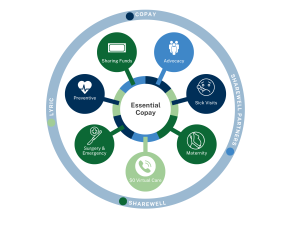
One of The Best Business Decisions I’ve Made
When I first considered moving away from providing traditional health insurance for my employees, I had my doubts. It felt counterintuitive. For years, providing group health insurance felt like the “right thing” to do as an employer. But rising costs, employee dissatisfaction, and the growing administrative burden made me question whether it truly benefited my team—or my business. Looking back, this shift was one of the smartest decisions I’ve ever made.
Here’s why stepping out of the benefits business was the right move and a transformative one for our company and our employees.
Empowering Employees with Choice
When we transitioned away from providing traditional health insurance, we gave our employees the freedom to choose coverage that worked best for them. Some opted for Health Share programs like ShareWELL, which offered a unique alternative to traditional plans for those who were a good fit. Others purchased plans on the healthcare exchange, where many qualified for financial assistance that significantly reduced their premiums—or even covered them entirely.
This freedom gave employees the power to tailor their healthcare to their specific needs and budgets, a stark contrast to the frustration they felt with the one-size-fits-all group plans we had previously offered.
Improving Employee Satisfaction
One of the driving factors behind this decision was recognizing that our employees didn’t truly appreciate the group plans we were providing. Each year, as rates increased and benefits diminished, frustration among our team grew. Employees often expressed dissatisfaction with us despite our best efforts to offer something valuable.
By empowering them to find and choose their own coverage, we changed the dynamic. Employees became more vested in their decisions and more informed about their options. Instead of feeling stuck with a plan that didn’t meet their needs, they now had control—and that control made all the difference.
Providing Support Along the Way
We didn’t leave our employees to navigate this change alone. To ease the transition, we brought in a local healthcare expert who served as a resource for employees needing guidance in selecting their plans. This ensured they had access to professional advice and felt supported throughout the process.
This small step of providing direction reinforced that we were still invested in their well-being, even if we weren’t directly managing their health benefits anymore.
Financial Wins for Everyone
One of the most immediate benefits was financial relief—for both the company and our employees. Without the burden of group insurance costs, we could give employees raises, redistributing some of the savings directly to them. This helped them cover their healthcare expenses and gave them extra flexibility in how to use the additional income.
For employees, the cost of coverage often dropped by half or more. Many who qualified for subsidies on the exchange could secure coverage at little to no cost.
Streamlining Operations
Another unexpected benefit was the reduction in administrative overhead. Managing healthcare benefits has been a complex and time-consuming process for our HR team. From plan renewals to compliance and employee inquiries, it often felt like we were running a mini insurance office on top of our actual business.
When we stepped away from providing health insurance, those responsibilities disappeared. Fewer internal resources were needed to manage benefits, allowing my team to refocus on what truly matters—our core business.
The Best Decision for Our Team
Ultimately, this decision improved our workplace. Employees were happier, more informed, and better equipped to manage their own healthcare. They appreciated our support and valued the increased control and flexibility.
Leaving traditional health insurance behind wasn’t easy, but it was right for us. It saved money, reduced administrative burdens, and, most importantly, empowered our employees to make informed choices that worked best for them.
Sometimes, rethinking the “standard” is the key to creating something better—for everyone.
